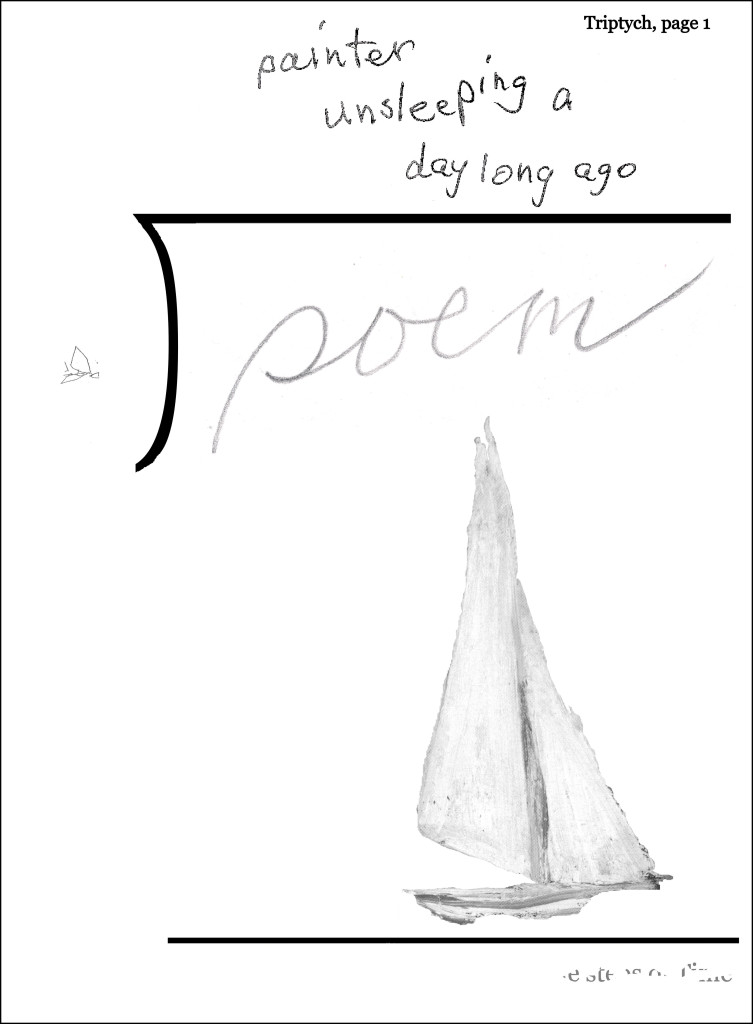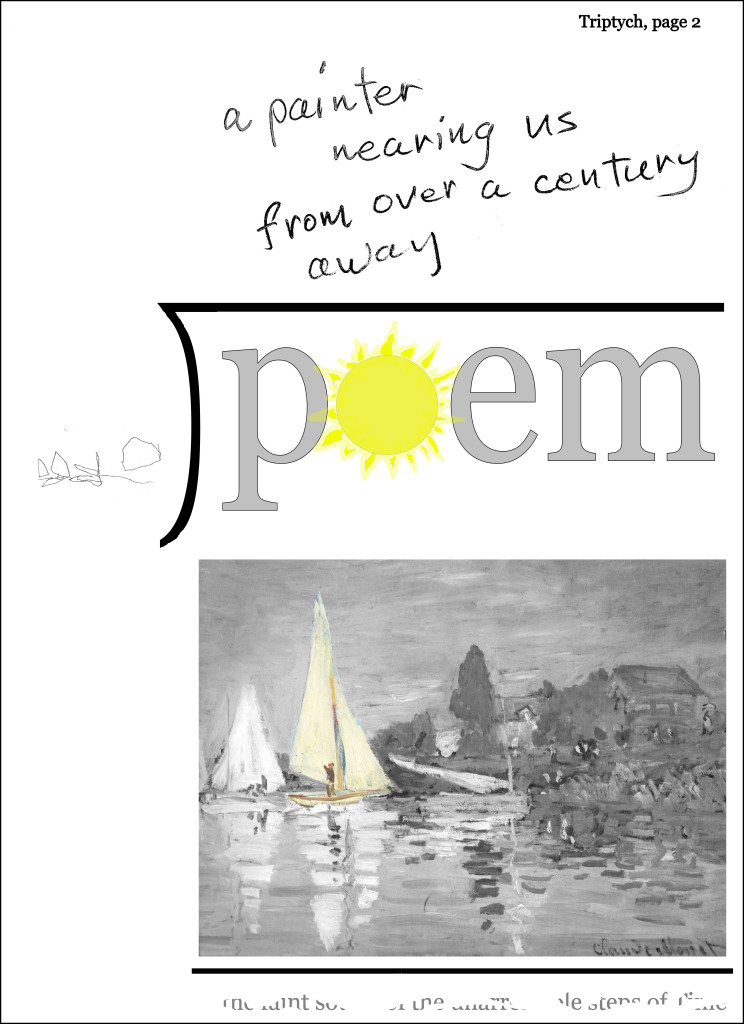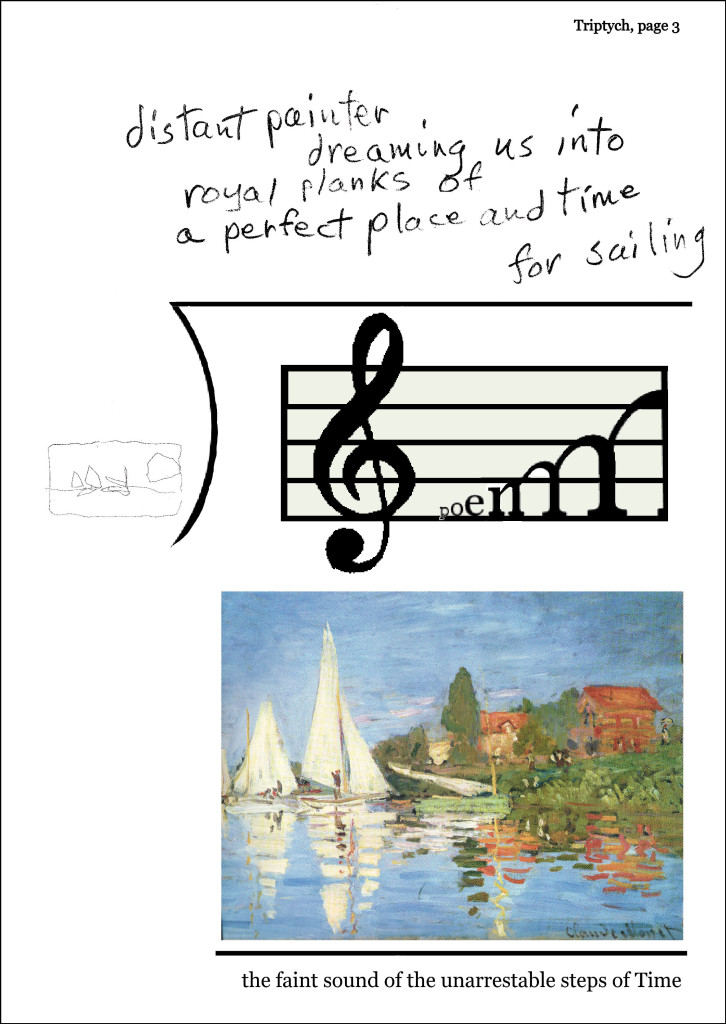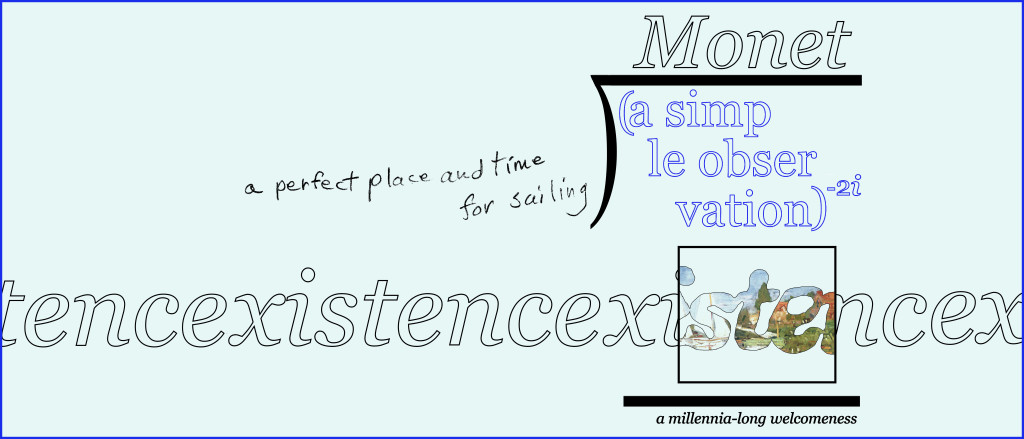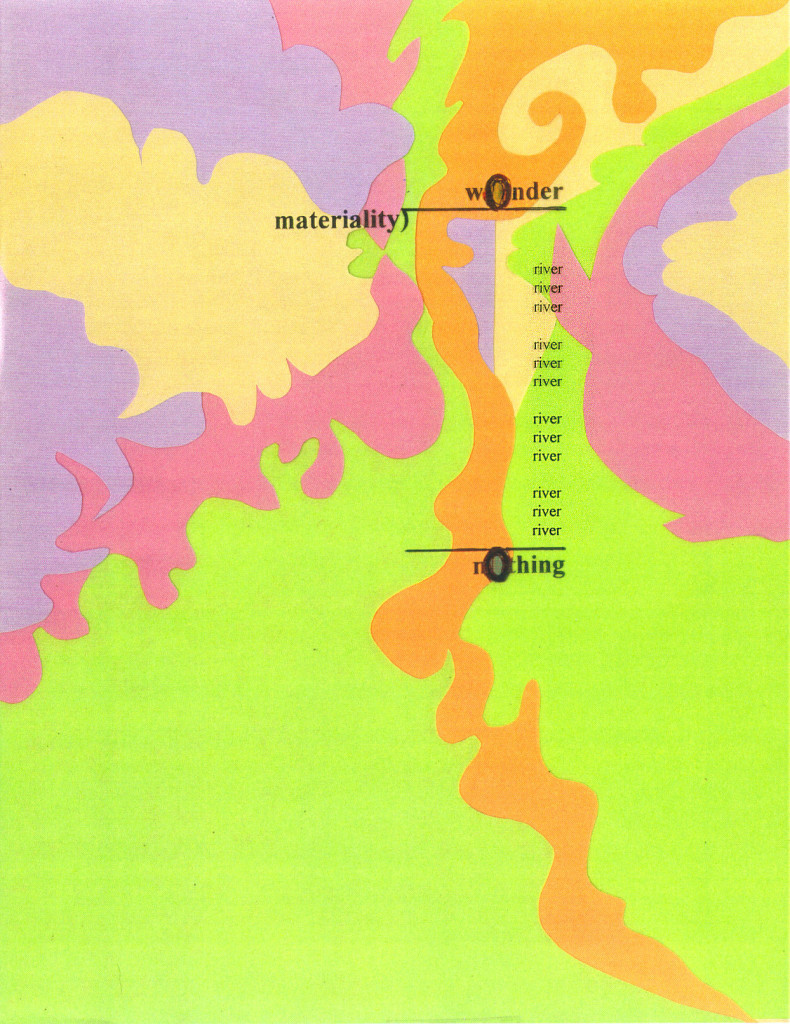22 October 2009: The following essay on d. a. levy (from #574) is either a review I wrote for the May 1992 issue of Small Press Review (my copy of which I seem to have lost) or an expansion of it I later did. Whichever, I think I did a pretty good job on it, although no levy scholar has paid any attention whatever to it:
d.a. levy, Pioneer in Visio-Textual Art
Zen Concrete & Etc.
by d.a. levy, edited by Ingrid Swanberg. 245 pp; 1991; Pa;
ghost pony press, 2518 Gregory St., Madison WI 53711. $29.50 ppd.
The initial charm of this nicely-produced, richly-illustrated large book is the immediacy with which it brings the sixties to life, at least for anyone who spent his twenties there, as I did. Just about everything of the era is in it: the sometimes jejune but always impassioned and compassionate politics; the sometimes jejune but always free-ranging and committed devotion to art; the struggles over obscenity, complete with busts; marijuana and various psychedelic drugs; the paraphernalia both physical and mental of exotic Oriental religions; and the wonderful, if sometimes frazzling, sense of everything’s coming to fruition at once.
Almost always an implicit or louder part of the textual poems that make up about half the book are the politics of the time, as in his “Suburban Monastery Death Poem,” for example, where he writes, “Really/ the police try to protect/ the banks – and everything else/ is secondary,” or in his four “visualized prayers to the American God,” which are comprised mainly of dollar signs.
The devotion to art is burstingly there in the sheer amount of poems and collages in the book, particularly considering that they are a mere selection from the ouevre of a man who died at 26.
As for the obscenity wars, they explode in the excellent over-view from the early seventies of levy’s life provided by Douglas Blazek. Twice, according to Blazek, levy was arrested for distributing obscene poems. AND THIS COURT HAS A RIGHT TO PROTECT KIDS FROM THIS KIND OF FILTH FOR THE SAKE OF FILTH AND NOTHING ELSE as one of the judges involved thoughtfully put it. Levy was clearly a victim of persecution, for one of his arrests was for publishing a poem by a minor that contained the word, “fuck,” in it. Although levy was never convicted of the charges against him, the persecution took its toll on him and certainly contributed to his eventually killing himself.
Drugs are only peripherally in levy’s poems and collages, but get more attention from levy’s friend, the poet D. R. Wagner, whom the book’s editor, Ingrid Swansen, interviews, and in the personal reminiscences of levy by Kent Taylor, as well as in a wonderfully black-humored fragment from a radio talk show featuring levy and a few of his friends which ends with a woman caller’s saying, “I think the boys are absolutely right! I think it’s great! Why don’t we all just bug out, and we’ll see who provides the groceries, and makes the shoes…” with Levy interrupting by asking who needs shoes and the host’s observing that levy is wearing a pair.
Buddhism permeates levy’s poetry and collages, though in tension with his propensity for agitation and despair. As for the sense of going-somewhere that the sixties symbolized for so many, it is there not only in levy’s poems and collages, but in the descriptions of his publishing (via offset and then mimeo), his organizing of and contributions to poetry readings, his leaving free copies of books he’d published at public libraries, and selling them on the street, and all his interactions with people like Ed Sanders and Allen Ginsberg.
By now it should be apparent that a signal virtue of this book is its bringing levy himself, through his friends’ reminiscenses of him, to life. Literary Biography and Social Document– as just these two things alone, Zen Concrete is well worth buying. But its greatest value is as a collection of levy’s art.
That begins with Zen Concrete, 1967, which consists of a sequence of what levy called “experiments in destructive writing.” Its first page contains something that apparently was a poem, but all its letters have been blacked out. Trivial? Perhaps. But considered as a kind of drawing of literary process, it begins to say more than On one level it says not of silence but of silenced writing–and this no doubt refers, in part, to the attempt of the police in Cleveland to silence levy as a poet by twice arresting him for purveying obscenity. But it also speaks of the poet’s disappointment with his medium. Also, the canceled words look like they’re seeping larger, flowing toward the paper’s edge, or even misting upward off it, into subtler expression. Other things that cross the mind: that some portions of the poem are only lightly scratched out, and others heavily, and passionately, defaced suggests the poem’s personality–as does its still apparent shape. As a composition its author turned against, it is amusing, too, particularly at its start, where lines between lines had to be canceled–as if the poet, dissatisfied with his effort first tried to rewrite the beginning of it, then gave up. The title, “Selected Writings,” which is left unmarked at the top of the page with levy’s name and the year of composition, suggests something of the artist’s sardonic self-contempt for his presuming to work up an Ouevre out of matter better blacked out.
But the piece is most important for setting up levy’s series as a whole. The second work in it, “Totem,” consists of more blacked out lines of print, but with a little oval sun added off to the left, and the text reversed (due, d.r. wagner informs us in an interview included in the book, to levy’s practice of “backfeeding” pages through his mimeograph). Most of the text is in a narrow, irregular column, and looks like a totem pole. But not all the letters in the thing have been blacked out. The result? Words in the process of going against themselves, and into self- obliteration in an act of worship? Or the reverse: letters backing out of a dying act of worship and on their way toward asensual pragmatism as normal words? Both, I contend–into a tension of opposed magics.
In the third segment of levy’s sequence cut-up texts are superimposed on a silenced text; one of the additions concerns Cambodian statues of the Buddha; another is a snippet that contains just the word, “(dharma).” The main addition, however, is an upside-down text, mostly blackened out. But scraps of material remain readable: “come,” “gain refuge” and “they didn’t,” among them in the upside-down portion; “red walls” “as twilight formed” and “staring at” in the rightside-up text it covers. Many meanings are possible: a world of words and orientations going meaningless, but with havens preserved within? And of course more than a hint of the salvation of levy’s brand of Zen. So, like many poets after him such as Doris Cross, John Stickney, Greg Evason, jwcurry and Tom Phillips, levy is here silencing a given text down to some poetic or otherwise aesthetically meaningful essence.
As the sequence continues levy adds more and more subteties, e.g., a half-page with just a few scattered fragments of illegible words above a text on . . . the Beginning, which opposes a page whose silenced text looks like a brick wall. As a whole, Zen Concrete becomes a treatise on the Varieties of Disintegration and Ressurection, as well as a visual poem one can go back to as often as one can to the best paintings.
A year later levy was adding visual cut-outs from girlie magazines, books of reproductions of Buddhist statues and other artworks, and elsewhere, while building on his techniques of textual destruction and collage for even richer though sometimes disorganized-seeming work that looks contemporary, and has had a wide if not yet academically- acknowledged influence on the best visual poets of the present..
Meanwhile he was turning out visio-textual work of an elegance that almost seems slick. Ny favorite of these appears to be something clipped from a Greek newspaper. Three circles of equal diameter have been collaged over the clipping, and two more circles of the same size drawn intersecting two of them. One of the first set of circles contains blown-up Greek lettering in white on a black ground; a second has similar lettering in black on a white ground. The texts are perpendicular to the clipping’s text. The third of the cut-out circles is mostly blank, with just a shade of small disappearing lettering. Some dots, a dotted line, a solid line and a bent line have also been drawn on the work to suggest, for me, some kind of geometric analysis.
What to make of such a jumble? I’m not sure. But I find all kinds of hints of antiquity versus the ultra-modern field that particle physics, with its extensive re-use of greek lettering, is; headline-topicality versus details of Final Importance that are turning away and rising from them. Platonic ideals.
As a textual poet, levy was not as significant or groundbreaking as he was in what I call “pluraesthetic art” to mean art that is meaningful in more than one aesthetic way, as visual poetry is expressive both as words and as visual images. An early extended poem, “Cleveland undercovers,” is mostly angry stream of consciousness near-prose in the manner of Ginsberg’s “Howl” about levy’s hometown, and perhaps greatest obsession, for he wrote about it constantly, and could not seem to leave it for more than a month or two at a time, in spite of the growing attentions of the police. But some of its lines have a poetic flare, for example, “i have a city to cover with lines,/ with textured words &/ the sweaty brick-flesh images of a/ drunken tied-up whorehouse cowtown/ sprawling & brawling on its back.” He was only 23 or 24 when he wrote it. Others of his longer poems are as energetic, and solider. My favorite of them (at the moment), “Warriors Rest,” performs all kinds of incantatory, surrealistic zigs on the idea of a “Spade Queen” as playing card, queen of night, queen of death, black woman, whose “dark dancing is/ a shadow moving across/ the moon at dusk,” versus a warrior’s white horses, and other whites until “later the shadows/ of new sun dances/ enter her mind/ like frightened moons// in the morning smoke/ like black bridges to cross.”
There is so much more to be said, but, oh, the Cleveland of space considerations! So I will end with my conviction that it would be no disservice to Keats, one of my greatest heroes, to describe d.a. levy as his 20th-Century American equivalent. |
In #575, I passed on an anouncement P. R. Primeau and Geof Huth had posted for an anthology called The Ghetto of Concretism devoted to concrete poetry of the strictest sort–nothing but textual symbols, for instance. I don’t know what came of this project or whether I submitted anything to it. Geof, like me, is great at coming up with project ideas like this that don’t go far.
After an entry in which I posted Klee’s The Villa R and boilerplated on and on about what kind of work it was, I reported in #577, that my Merriam Webster’s Collegiate Dictionary defined “eme” as “significantly distinctive unit of language structure.” Ergo, all the “eme” neologisms I’d recently come up with (“texteme,” for instance, for “unit of language structure having to do with textual material”) were as clear and reasonable as such words can be!
This led to the following list of coinages in #577 through #580 (inspired by “morpheme” and “grapheme”):
“techneme” for technical term having to do with language.
“enhanceme” for
“denoteme” for verbal element that denotes.
“connoteme” for verbal element that denotes. (Yes, one word can be two or more emes.) “rhetoriceme” (soft c) for rhetorical element.
“paralleleme” for verbal element that is part of a parallelism.
“poetreme” for unit of poetry.
“repeneme” (an old one) for repeated textual element–such as the alliterative l in the text, “loony lout.”
Eventually, the list changed to one concern with varieties of schemes present in poems:
“poetic scheme” for any possible way a poem can be shaped as a scheme consisting of the units defining the shape–e.g., rhyme scheme. A texteme scheme will use x’s or the equivalent to show where each texteme in a poem is. Or x’s and X’s, to indicate size. A linguexpressive poem’s texteme scheme would be its overall abstract shape. A poem in general’s “aestheme” scheme would be its overall abstract shape. Right now it seems to me that the only other consequential schemes linguexpressive poetry uses are repeneme schemes. Visimagistic schemes, color schemes and the like would come into play in visual poetry, and musical schemes for sound poetry, and so forth.
I decided that now that I had the terms, “poetic scheme,” and “poetreme,” I could get around the form/content problem by stating, simply, that every poem consists of just two fundamental things: poetic schemes and poetremes. All these term will make more sense when I get around to making an essay of the material in #558 through #568 and #571 through #573. Note: I do believe I have more than I need–and that one or more may be ridiculous.
23 October 2009: Last night I had another of my moments of Important Versophical Insight. It came upon me that aesthetic pleasure, while necessarily sensory pleasure, could also (but needn’t) be narrative and/or conceptual pleasure. A work of art may also give an engagent moral pleasure, but it needn’t, and I claim that such pleasure is different from aesthetic pleasure. Indeed, if the moral effect of a work purported to be an artwork is greater than its aesthetic effect, it cannot be called an artwork but must be called a work of advocature–because its main function will be to persuade rather than to delight.
As always, I am bemused by how brilliant I consider a thought of mine–and at the same time embarrassedly wonder why it took me so long (decades) to come up with so banal and obvious a one.
(I hope Karl Kempton, who criticized me for excessive use of neologies in my discussion of aesthetics reads this and sees that while I could have called “sensory, narrative and conceptual pleasure” “initiaceptual, sagaceptual and reducticeptual pleasure,” to connect it to my theory of psychology, I didn’t. “Narrative pleasure,” by the way, is simply the pleasure stories of people, or animals or things acting like people, as they pursue some goal and succeed or fail to attain it. “Conceptual pleasure” is the pleasure pure ideas can give one, and pure design.
Now, back to my still ongoing project to #583 for “paramorpheme,” meaning “textual element other than morpheme, such as a punctuation mark, to add the list of “eme” words I expect all my visitors to have copied.
Next, the following piece, which is by Nico Vassilakis, was in two of my entries, #581 and #582:

In #584 I observed, unbrilliantly but correctly, that the (necessary) jargon or any original verosophical undertaking should be introduced gradually. In my next entry I showcased Andrew Russ’s most excellent
lst
last
then an entry trivial even for me on terminology followed by one where I cross swords with Marcus Bales again–actually, it was more Kaz Maslanka crossing swords with him on my behalf at New-Poetry, for Marcus was attacking my math poetry.
In #588 I discussed my struggle to find a term meaning, “text that has been poetically misspelled,” finally coming up with “errographism”–“air RAH gruh FIZ ‘m.” I reported that I’d changed the remainder of my division of poetry by metaphor to “forsythia” in #589, and noted that a selection of my Poem poems Mary Veazey had posted at her Sticks site had gotten a nicely favorable (and, I thought, intelligent) review from Particle in Light. Finally, in #590, I wrote scornfully of a statement of Pound’s, “Take a man’s mind off the human value of the poem he is reading (and in this case the human value is the art value), switch it on to some question of grammar and you begin his dehumanization.” Jeff Newberry had posted it at New-Poetry, asking us to guess who wrote it. I didn’t know, and was very disappointed to find out Pound had said it, but opined that it probably made more sense in context than it did by itself, and that although Pound said a lot of stupid things, I still considered him one of the very few people every who had written intelligently about poetry.
24 October 2009: My next set of ten entries began with one reporting that I’d returned to my “Arithmepoetic Analysis of Color” sequence to good effect, determining all the terms of one (the division of orange), and a good half of the terms of the second (the division of green). That was slightly more than four years ago, but I haven’t yet even begun to finish either of these. Typically. I added a few further comments on the unfinished pieces in my next entry, along with an epigram of sorts: “Give me a religion in which reverence is mandatory, kneeling forbidden.”
In the next entry, #593, I said I believed many of my most important life-moments have occurred when I’ve been in books. I would now amend that to “Many of my most important and happiest moments have occurred when I’ve been in a work of literature, someone else’s or my own.” Many of my other hapiest and important moments have occurred when I’ve been in some other form of art. In other words, I was meant for a kind of sub-life, not life. I have a few happy, important moments in real life, too–but not many.
#594 has some works by Tommaso Marinetti I stole from a website I was directed to by Karl Kempton. It would seem that Marinetti was as important for the introduction of modern visual poetry as Apollinaire, but coming out of visual rather than verbal art. (Note, running into Karl’s name in this entry reminded me of how valuable a follower of my blog he’s been over its five plus years–however upset with each other we’ve sometimes been.)
In my next entry I posted a 1914 piece by another Futurist, Carlo Carra: |
